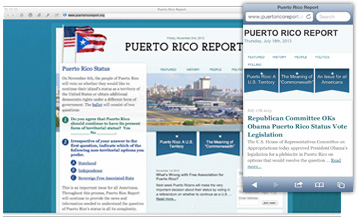Your cart is currently empty!

More on Moving Old Websites
I’ve written before about moving large websites, but I’m currently in the midst of moving the content of a wonderful, huge, old website to its new, even more wonderful WordPress home, and I’m realizing that there are a lot of issues I didn’t mention.
This website, The Puerto Rico Herald, has more than 12,000 indexed pages. It was one of the earliest online newspapers; in fact, Wikipedia’s earliest listing is for 1999, and the Herald beats that date by a year. In those days, people making a newspaper online would create a static web page that looked like a newspaper, linking the headlines to the full stories on other pages. The next issue would be another page of the same kind.
This means that the old site is built up of numerous successive homepages, many in separate versions in two languages, plus many original and reprinted articles linked from the various pages, plus multiple static archive pages of various kinds, often in both Spanish and English versions. It’s pretty exciting to work with.
Few of us have this kind of behemoth to work with. But you may have an old site (lucky you!) with lots of stuff on it, making the task of moving and updating daunting. I’ve moved old sites that had simply unlinked their old pages, so that the site contained a graveyard of unlinked pages, and others that had sorted their site into a few bins, as it were, creating something like “articles” with dozens or hundreds of subpages. When you think about working with something like this, your inclination may be to give up.
Don’t do it. Come up with a new organizational structure that will work for your organization’s current goals, find all the old content and determine what ought to move, and make it look great in its new home. It will be worth the effort.
Here are some of the issues that may arise as you work:
- What needs to move? It’s not a bad idea to download everything to a disc for your company history file, but moving outdated material isn’t a good plan. Duplicate or “thin” content shouldn’t be moved, for the good of the website; nor should confusing things like documents with information that’s no longer true or documents that don’t fit the new structure of the site. The Puerto Rico Herald’s new home will be English-only, so we’re not moving the Spanish materials. As you can see, decisions about what to move and what to leave out can require some serious thought. If you have analytics data, you should also consider which pages still receive visits.
- Formatting As technology has changed since 1998, the formatting of the various articles in the newspaper has also changed. Obviously, we want them all to end up in the same format. We tried out a variety of approaches, and have found that the best one has been to copy the content from the website, to paste it into the WordPress HTML post box, and then to go in and format it. If your site doesn’t span so many years, there may be other possibilities that work better for you. It’s worth trying a few, though, when you have many hours of work of this kind to do, because there will be one method that’s more efficient for the material you’re working with.
- Links After a few years, our newspaper began to link to other sites on the web. Naturally, many of these sites are no longer live, or no longer contain the information originally linked to. Check them, and either update them or remove them. Also, if you’re working at various time depths, you’ll find different kinds of anchor text, from bare URLs to “click here.” Update them all to provide clear anchor text that describes the destination.
- Invitations and calls to action The site I’m working with has lots of exhortations to vote in polls, call for tickets, visit restaurants (with 20th century prices listed), and buy books. Don’t leave those things to confuse your visitors. If the page you’re looking at exists only to bring about the outdated action, don’t move it. In the case of the newspaper, there are gracefully written travel articles that people will still enjoy, and discussions of events that are of historic importance, even if no one is polling about them any longer. A bit of rewriting lets you preserve the content without confusing visitors.
- Pictures and videos Old photos can make your site look dated. Unless you’re clearly presenting them as historic (which is of course the case with some of the newspaper’s photos), remove them. One particular case where we’ve seen this come up is in photos of the company’s staff. When people see your youthful photo from a decade or two past and meet you, there’s a sense of shock that doesn’t get the relationship off to a great start. Same with the photo of the company’s old building, which won’t match Google’s street view — or perhaps you’ve moved and your customers can’t find you at all because they’re looking for the wrong building. Even when the picture doesn’t require you to say, “Uh, yeah, that’s an old picture,” consider whether the size, colors, and style are what today’s web surfers expect.
Have I left anything out? How have you coped with the challenges of moving an old website?
by
Tags:

Leave a Reply